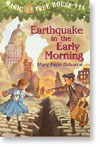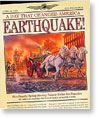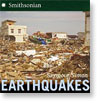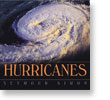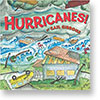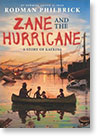How can parents and educators talk with kids about natural disasters like the 2017 hurricanes in the Caribbean and the earthquakes in Mexico, the 2010 earthquake in Haiti, and the 2004 tsunami in Southeast Asia?
All of these natural disasters happened “over there,” in countries that seem — to many U.S. students — far, far away as measured by miles and cultural differences. In 2005, Hurricane Katrina devastated one of our own cities, New Orleans, and brought the reality of natural disasters closer home.
The Reading Rockets staff wanted to do something to help parents and educators address the disaster, but what? We’re not a news or international agency or counseling group, we’re an organization about reading and books. And that’s when we got our a-ha moment.
One of the best resources for discussing the natural disasters with kids may in fact be children’s books. In the book Life Doesn’t Frighten Me , poet Maya Angelou’s text urges us to face what frightens us, whether it is real or imaginary. Haitian-American artist Jean Michel Basquiat’s full-color paintings capture just how challenging it is to be brave.
Using picture books to make a connection
Quality children’s picture books — richly illustrated and often poetically written — can introduce young readers to people, places, and times they might not otherwise experience. The books may reveal differences in dress, language, and landscape, but the stories and emotions are recognizably the same, no matter what latitude and longitude you live in.
To help children in the U.S. to understand better what is going on in another part of the world, a good starting point is to read stories about children who live in the affected country. Many multicultural stories and folktales have universal themes — like going shopping with mom or walking to school with friends — that allow a child to connect with children in a faraway place like Haiti. Through the picture books, your kids can recognize children whose lives are outwardly different but inwardly the same as their own. This is where empathy begins.
Some kids have a driving need to understand better what actually happened, and why. Reading together a quality nonfiction book about earthquakes may help lead into a broader discussion about where earthquakes can occur, where Haiti is in relationship to your home, the Haitian people, and how you can help. Historical fiction is another genre that can help a young child understand a current event. Stories in this genre take kids back to a time and place and help them imagine how they might feel if they were in a similar situation. No matter what the genre, the discussion that goes on around the books is key.
Guidance from parents and teachers
It’s important not to scare children when talking about something powerful and real like an earthquake. Parents and teachers should take care to assure children of how rare an event it was and how safe they are. Many websites for children, such as Time for Kids , do a good job of screening out inappropriate images and news while providing an understanding of what happened.
Children’s books are both a timely and timeless resource because of the way they encourage kids to make a connection to the people and places portrayed. They build upon the news and facts by providing a context for understanding who was affected and what was lost. With the guidance of a parent or teacher, picture books can be used to develop understanding and empathy and perhaps the will to help.
Kids who care can have an impact. A child who ties a ribbon around a tree may motivate someone else to act. Children can write letters thanking and encouraging rescue workers. Older kids can talk about what makes an effective donation — should we ship used clothes or send money? — as well as how to fundraise or choose a trustworthy and effective charity.
In the end, neither children nor adults can control natural disasters. What we can do, though, is encourage feelings of compassion and a helpful response.
Learn more
Browse this related resource from our sister project, Colorín Colorado: Helping Children After a Natural Disaster
Children's books about countries of the world
Visit our Book Finder tool to find books featuring stories and information about the people and cultures from different countries and regions of the world.
Children's books about natural disasters
Earthquakes
Earthquake in the Early Morning (Magic Tree House #24)
by Mary Pope Osborne
It’s a quiet, peaceful morning in San Francisco, and Annie is eager to start exploring. All too soon, the siblings figure out that they have arrived in this lovely city a moment before one of the biggest earthquakes the U.S. has ever known shakes the Bay Area to pieces! Stunned, Jack and Annie wander the streets, but quickly find a purpose. Lots of people need help transporting goods to safety, and many more are left without any idea where to go or what to do. [Amazon]
A Day That Changed America: Earthquake!
by Shelley Tanaka
Using dramatic material culled from the adult recollections of four survivors, Tanaka re-creates a series of events during and following the great San Francisco earthquake of April 18, 1906. Liberally laced with contemporary photos and some colorful artwork, the book also contains fact boxes on earthquakes, fire horses, and Chinatown. [School Library Journal Review]
If You Lived at the Time of the Great San Francisco Earthquake
by Ellen Levine
This book takes you to San Francisco, California, shortly before, during, and after April 18, 1906. What would you have done when the quake struck? [Amazon]
Earthquakes
by Seymour Simon
A visually outstanding book with large, high-quality, full-color photographs depicting earthquake damage. Simplified, yet accurate, nontechnical language is used to describe the geologic processes that cause earthquakes, their impact on people, and some devastating historic events. [School Library Journal review]
Earthquakes
by Franklyn M. Branley
The simple, easy-to-read narrative describes the causes and effects of earthquakes (including a tsunami) and safety measures to be taken during one. [School Library Journal review]
Jump into Science: Earthquakes
by Ellen Prager
What causes earthquakes? Where do they happen most? What should you do if you feel the earth shake? Just follow the friendly crow-in-the-know for all the answers. [Amazon]
Hurricanes
Hurricanes
by Seymour Simon
Hurricanes, their origin and their destructive power (as well as their relatives, the tropical storm and depression) are presented here in striking photographs and cogent text.
Hurricanes!
by Gail Gibbons
Young readers will learn how hurricanes are formed, how they are named and classified, and what to do if a dangerous storm is on the way.
Magic School Bus Inside a Hurricane
by Joanna Cole and Bruce Degen
Ms. Frizzle’s class gets the inside scoop on hurricanes by going into its eye in their school bus (turned weather plane) to learn how hurricanes form and to experience their power.
Marvelous Cornelius: Hurricane Katrina and the Spirit of New Orleans
by Phil Bildner
Cornelius Washington was proud of his hometown, New Orleans. His job as a sanitation worker became even more important after when Cornelius worked with others to help restore it. The story combines fact with fiction for a moving look at a catastrophic event.
Over in the Wetlands: A Hurricane-on-the-Bayou Story
by Caroline Starr Rose
As a hurricane approaches, animals and their behavior before a storm are described using the cadence of the familiar rhyme, “Over in the Meadow,” Handsome, realistic illustration evoke the mood of the weather and its impact.
Zane and the Hurricane: A Story of Katrina
by Rodman Philbrick
Soon after 13-year old Zane travels from New Hampshire to visit his great-grandmother, Miss Trissy, in New Orleans, disaster strikes. He and Bandy, his dog, confront the storm and the natural and human disastrous aftermath when they are separated from Miss Trissy and make their way back to Zane’s family. This thought-provoking novel is taut and fast-paced.
Recommended websites
News and information about natural disasters for kids:
- Ready.gov
- BBC Earth: Natural Disasters
- National Geographic Kids: Hurricanes
- National Geographic: Forces of Nature
- Weather Wiz Kids: Natural Disasters
- PBS LearningMedia: Natural Disasters
- Newsela
Sites about kids taking action and connecting with their world:

